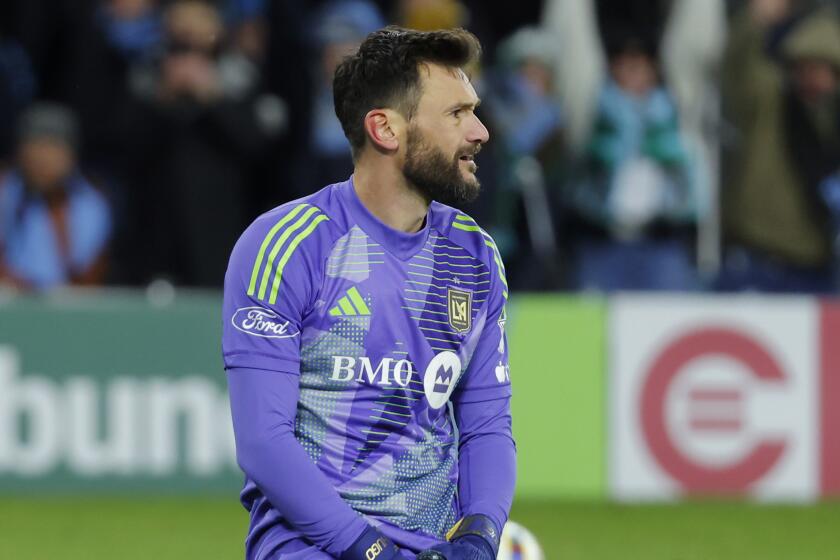U.S. making a public bid for a future World Cup
T.C. Boyle could not have invented a more disparate or odd set of characters, or have placed them in a stranger setting.
There they were, at night, in a luxury suite in a soccer stadium in the middle of the South African bushveld, within walking distance of a snake park advertising 40 varieties of reptile and a curio stand offering life-size wooden replicas of animals that once roamed free but long since ceased to do so.
They were five people from five very different walks of life. Joseph “Sepp” Blatter, the Swiss public relations man who doubles as the president of FIFA, world soccer’s governing body, was one. Bill Clinton, once president of the United States, was another. Also, television anchor Katie Couric; Sunil Gulati, the India-born president of U.S. Soccer, and Sir Michael Philip “Mick” Jagger, singer and soccer fan.
As a side note, Blatter is 74 and Jagger, sad to say, will be 67 this month. Where did the time go?
Anyway, there they were, at the Royal Bafokeng Stadium in Rustenburg last weekend, watching the U.S. play and eventually lose to Ghana in the second round of the World Cup.
Blatter was there because, well, he’s everywhere. Jagger was there because he is a U.S. fan, a holdover, perhaps, from headier days when he used to show up at New York Cosmos games.
Couric was there as a journalist. The presence of Clinton and Gulati, however, was more calculated, more based on future hopes and dreams, more interesting altogether.
Clinton is the honorary chairman of the U.S. Bid Committee to bring the World Cup back to American shores in 2018 or, if not then, in 2022. Gulati is the committee’s real chairman.
Gulati has assembled an intriguing group of people to be on this committee, from Mia Hamm to Henry Kissinger, plus Morgan Freeman, Arnold Schwarzenegger, Brad Pitt, Drew Carey, Spike Lee and New York Mayor Michael Bloomberg.
Gulati, now in his second term at the helm of U.S. Soccer, is upbeat about American chances to land another World Cup, but a lot can happen in the five months before FIFA’s executive committee takes its votes and announces its decisions on Dec. 2 in Zurich, Switzerland.
Both World Cups will be awarded on that date.
“I am feeling good about things but not taking anything for granted,” Gulati said this week, adding that Clinton’s trip to South Africa had been a massive boost for the bid.
“Frankly, I can’t say enough about President Clinton’s visit and the positive impact that had in many ways, on the FIFA executive committee members that he met with and with the locker room visits to the [U.S.] team,” he said.
“The attention it’s brought to the sport has been terrific. For a former president to get to two games was pretty extraordinary for us.”
Vice President Joe Biden also flew to South Africa and sat down with Blatter for 45 minutes. Chances are the VP was telling about assurances being made for 2018 and 2022.
Not that the U.S. needs to gild the rose. It has the stadiums. It has the infrastructure. It has the fans. It has the interest.
The 1994 World Cup in the U.S. is still the best attended and most profitable of any of the 19 tournaments held to date. South Africa 2010 will not surpass it and neither will Brazil 2014.
So the U.S. has not had to push really hard. Not yet, anyway, but it is beginning to make some moves.
“We’ve followed a very low-key approach,” Gulati said. “We’ve come out of the box a little bit with the vice president being here and President Clinton being here. I think our message is on track.”
There is a possibility, given the strong sentiment for the 2018 World Cup to be held in Europe after Africa 2010 and South America 2014, that the U.S. might yield that year in return for Europe’s supporting the U.S. in 2022, but no deal has yet been struck.
Would Gulati be satisfied with 2022?
“Sure,” he said. “Sure.”
Would he still be in charge in 12 years?
“Who knows?” he replied. “Certainly, spending a couple of days with President Clinton reminded me of the silliness of term limits.”




